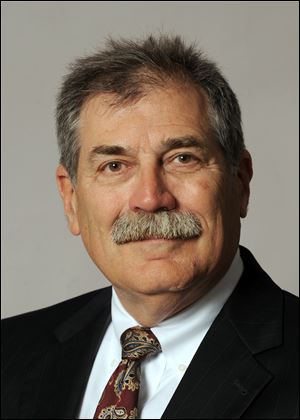
Ohio school aid plan aims for achievement everywhere
2/24/2013
Ross
As a former superintendent of several Ohio school districts, including the Bryan and Ottawa-Glandorf districts in northwest Ohio, I know from long experience that the presentation of the state’s school-funding projections is always an anxious time.
So it came as no surprise this month when some of my former colleagues expressed disappointment that their districts were flat-funded in the new state budget proposal. To get a true picture of Gov. John Kasich’s proposed school-aid formula, though, we need to examine the changing demographics of Ohio school districts.
Many communities have experienced major fluctuations in their property tax base as a result of the housing bust. Student enrollment also has changed significantly in many schools. Since property values and student populations are primary factors in aid calculations, these changes have had significant effects over the past five years
The core funding calculation in Governor Kasich’s Achievement Everywhere Plan is focused on directing dollars to students and their learning needs in the classroom. Districts that have experienced considerable student population growth in recent years are getting funding increases.
But districts with shrinking student populations would have seen potentially destabilizing funding cuts, had it not been for the governor’s insistence on guaranteeing every Ohio school district at least as much state money as it got last year. These districts may be flat-funded under the plan, but that’s better than the pain they would have felt if not for the guarantee.
Even so, urban districts and those with low property valuations will get a greater portion of the state’s money — 62.7 percent of formula aid — than higher-wealth districts. The state spends $5,877 per pupil in Toledo Public Schools, compared to $1,694 per pupil in Sylvania.
This is what the governor meant when he said that “if you are poor, you’re going to get more ... if you are rich, you are going to get less.” The new funding formula ensures a fair, evenhanded, and common-sense way to support our students.
As a superintendent, I thought I grasped the wide disparity that historically has existed in funding Ohio’s public schools. I knew that the amount of money raised by one mill of tax on property value in my former suburban district was not as much as a mill might raise in surrounding districts.
But I had no idea of the depth of that disparity. The state-required 20 mills of property tax raise only $900 per pupil in some parts of Ohio, while they raise $14,000 in others.
To help reduce this gap, the governor’s plan is designed to ensure that all school districts will get the same amount of money as a district with a $250,000-per-pupil tax base of property values at 20 mills. Only four percent of Ohio districts have a higher tax base than that.
Funding levels are further adjusted to address districts that have high property values but large numbers of low-income residents. No district will get less state funding in the next two school years than it gets now. And expanded funding will support needed aid for disabled students, early childhood programs, gifted students, and those students who aren’t yet proficient in English.
In today’s tech-savvy world, we can’t solve tomorrow’s problems with yesterday’s solutions. That is why the governor’s plan creates a $300 million Straight A Fund, to reward schools that propose creative, sustainable ways to promote innovative teaching and learning or to improve efficiencies.
Money alone cannot help our schools reach their full potential. We need to reduce operating mandates that stifle creativity, and give our teachers and administrators the flexibility they need.
At the same time, health and safety requirements will remain priorities, and we will work to ensure that our students have the knowledge base they need to graduate from high school. We also will develop tools to show districts and their communities how they compare to their peers against important performance and efficiency benchmarks.
Ohio is in a period of renewed economic growth. Ohioans’ ability to benefit fully from that growth depends in large part on a strong system of schools.
We cannot continue to operate in the shadow of old funding methods and outdated paradigms that have plagued Ohio schools for years. Improving education and the way we fund it will help keep our state moving forward.
Richard Ross directs the Governor’s Office of 21st Century Education.